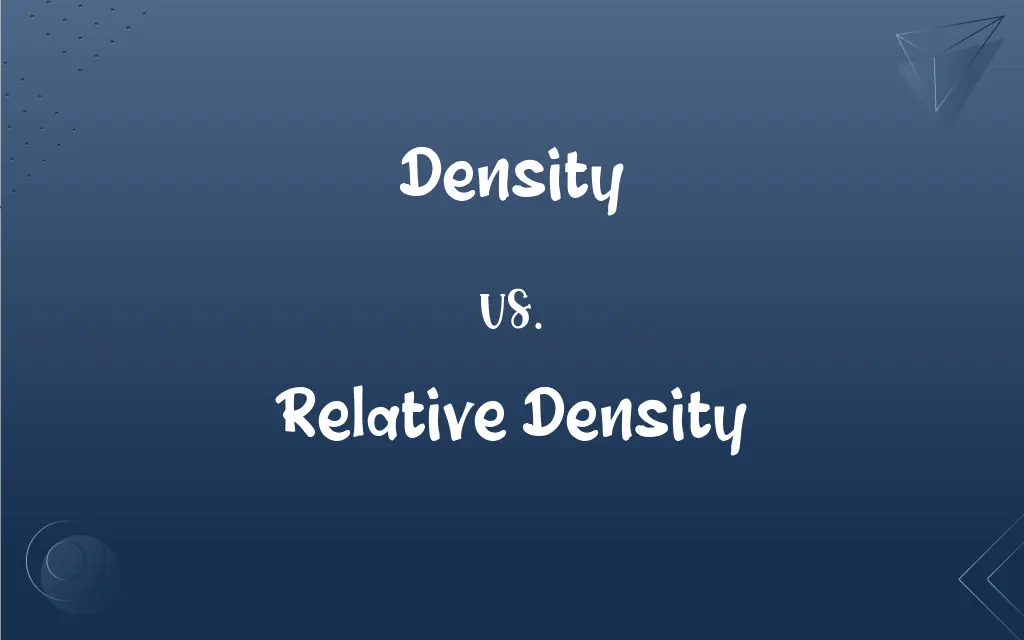Density vs. Relative Density: What's the Difference?
Edited by Harlon Moss || By Janet White || Published on February 29, 2024
Density is the mass per unit volume of a substance, while relative density compares the density of a substance to that of a reference substance.

Key Differences
Density is a fundamental physical property of matter, defined as mass per unit volume (e.g., grams per cubic centimeter). In contrast, relative density, also known as specific gravity, is a dimensionless quantity that compares the density of a substance to that of a reference substance, usually water for liquids and solids, and air for gases. While density provides an absolute measure, relative density provides a comparative one.
The value of density is expressed in units of mass per volume and depends on the temperature and pressure of the substance. Relative density, being a ratio, is a unitless measure and indicates how many times a substance is denser or lighter than the reference. This distinction highlights density's dependence on physical conditions versus relative density's contextual comparison.
Density is used to identify a substance or determine its composition. Relative density, on the other hand, is often used to determine the purity of a substance or its concentration in a mixture. Density offers a precise quantitative measure, while relative density provides a comparative analysis based on a standard reference.
In practical applications, density is crucial in fields like material science, engineering, and chemistry for designing and testing materials. Relative density finds extensive use in industries such as petrochemicals and food processing, where comparison to a standard is necessary for quality control and assurance. Each serves a specific purpose based on the requirement of absolute or relative measurement.
Calculating density requires measurements of mass and volume. For relative density, it involves comparing these measurements to those of the reference substance under identical conditions. Understanding both concepts is essential in various scientific and industrial applications, with density providing the fundamental property and relative density offering a means for practical comparison.
ADVERTISEMENT
Comparison Chart
Definition
Mass per unit volume of a substance.
Ratio of the density of a substance to a reference.
Units
Kg/m³, g/cm³, etc.
Unitless (ratio).
Dependence
Depends on temperature and pressure.
Mostly independent of units and conditions.
Usage
Identifying substances, determining composition.
Determining purity, concentration in mixtures.
Practical Application
Material science, engineering, chemistry.
Petrochemicals, food processing, quality control.
ADVERTISEMENT
Density and Relative Density Definitions
Density
It measures how compact the mass in a substance is.
A high density material was chosen for the construction due to its strength.
Relative Density
It's a comparison of the heaviness of a substance to that of water.
The substance's relative density was greater than 1, so it sank in water.
Density
Density varies with temperature and pressure.
The density of air decreases at higher altitudes.
Relative Density
Important in industries for determining concentrations.
Relative density helps in determining the concentration of solutions in the lab.
Density
Essential in calculating the buoyancy of objects.
The boat's buoyancy was determined by the density of the water.
Relative Density
Relative density is the ratio of the density of a substance to a reference substance.
The relative density of the oil was less than 1, indicating it would float on water.
Density
Density is the mass of a substance per unit volume.
The density of lead is much higher than that of aluminum.
Relative Density
Relative density is unitless and independent of location.
Since relative density is a ratio, it remains the same worldwide.
Density
Used to characterize the heaviness of different materials.
We calculated the density of the liquid to ensure it was suitable for the application.
Relative Density
Used to test the purity or quality of substances.
We measured the relative density to check the quality of the gasoline.
Density
The quality or condition of being dense.
FAQs
What is density?
Density is the mass of a substance per unit volume.
Why is density important?
Density is important for identifying substances and determining their properties, such as buoyancy.
What is relative density?
Relative density is the ratio of the density of a substance to that of a reference, usually water.
What does relative density tell us?
Relative density indicates how a substance compares in density to a reference substance like water.
Is relative density a unitless measure?
Yes, relative density is unitless as it's a ratio.
How is density measured?
Density is measured in units like kilograms per cubic meter (kg/m³) or grams per cubic centimeter (g/cm³).
Can density change with conditions?
Yes, density can change with temperature and pressure.
What role does density play in buoyancy?
An object's buoyancy depends on its density relative to the fluid it's in.
Is relative density the same everywhere?
Yes, relative density is independent of location and conditions since it's a ratio.
How does temperature affect density?
Generally, density decreases as temperature increases, as substances expand when heated.
Why is relative density important in the petrochemical industry?
It's used to assess the quality and composition of petrochemical products.
Does relative density affect an object's floating or sinking?
Yes, if relative density is less than 1, an object will float; if more, it will sink.
How do you calculate density?
Density is calculated by dividing the mass of a substance by its volume.
What is the typical reference substance for relative density?
Water is the typical reference for liquids and solids, while air is often used for gases.
Can relative density be greater than 1?
Yes, if a substance is denser than the reference substance, its relative density will be greater than 1.
What is a practical use of density in everyday life?
Density is used to calculate the amount of ingredients required in cooking based on their weight and volume.
Why is density used in material science?
In material science, density helps in designing products and understanding material properties.
How does relative density apply in the food industry?
Relative density is used in the food industry to determine concentrations and purity of substances.
About Author
Written by
Janet WhiteJanet White has been an esteemed writer and blogger for Difference Wiki. Holding a Master's degree in Science and Medical Journalism from the prestigious Boston University, she has consistently demonstrated her expertise and passion for her field. When she's not immersed in her work, Janet relishes her time exercising, delving into a good book, and cherishing moments with friends and family.
Edited by
Harlon MossHarlon is a seasoned quality moderator and accomplished content writer for Difference Wiki. An alumnus of the prestigious University of California, he earned his degree in Computer Science. Leveraging his academic background, Harlon brings a meticulous and informed perspective to his work, ensuring content accuracy and excellence.































































